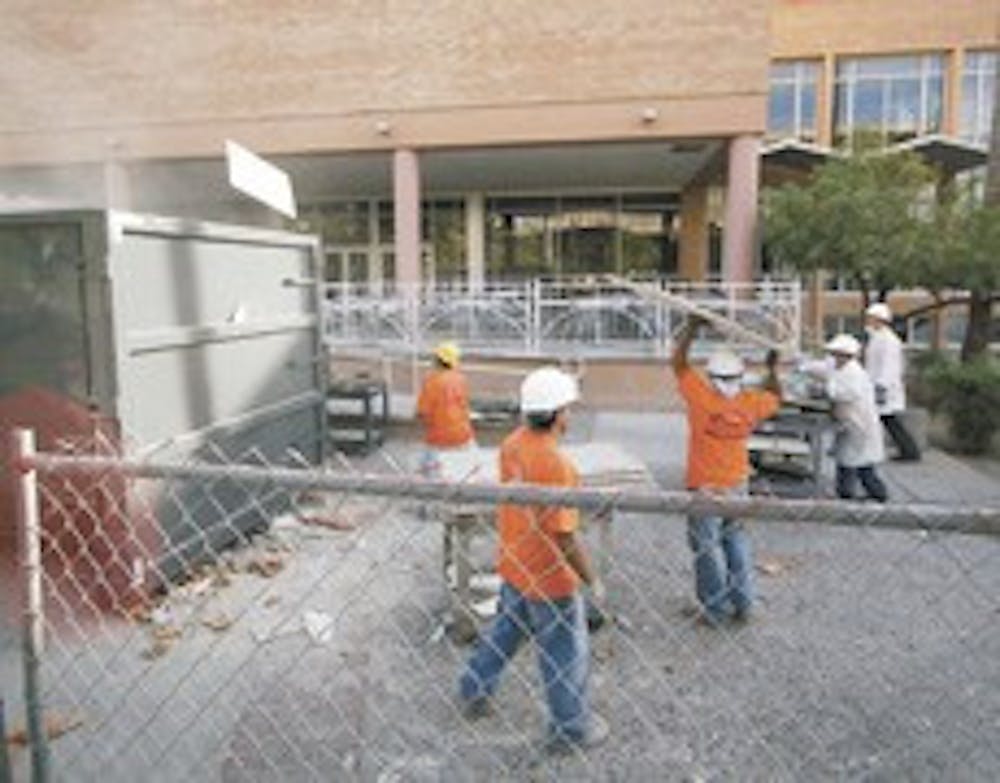ASU Tempe campus sprinkler coverage
Newly constructed buildings on campus have them. So do residence halls. But not the second floor of the Memorial Union.
And when a fire broke out there last Thursday, it was the absence of a sprinkler system in most of the MU that came to the media's forefront. The fire, which did not result in any injuries, started in a storage room next to the Arizona Ballroom on the Union's second floor, which houses meeting rooms and a restaurant.
Sprinkler systems usually don't extinguish a fire on their own, but they can hold a fire in check until firefighters arrive and keep the flames from spreading, University Fire Marshal Jim Gibbs says.
At a conference in 2005, Gibbs told fellow fire officials that ASU's goal is to protect all of its buildings with sprinkler systems.
Though ASU hasn't achieved this goal, the University is ahead of many others nationwide in protecting buildings with sprinkler systems. But the University is still dealing with budget constraints that leave many older campus facilities, like the MU, more vulnerable to the risk of fire.
MU sprinklers were in the works
Gibbs says this week that the second-floor MU ballrooms had been near the top of the sprinkler wish list, but the planned upgrade depended on funding.
"Our priority No. 1 building to sprinkle was the MU," Gibbs says. "The reason why they do it in phases is they only have so much money."
Sprinklers had already been added to much of the first floor during restaurant renovations this summer, he says.
"The next phase, which was to be completed here in a few weeks, was to finish sprinkling the back kitchen and the coffee shop," Gibbs says.
After finishing the first floor, Gibbs says the University hoped to add sprinklers to the second-floor kitchens. Sprinklers in the ballrooms would follow when money became available.
"We didn't have any funds for the ballroom," he says. "We know we had the funds to finish the first floor."
The building's alarm system was also pegged for an upgrade.
"Getting those done took precedence over any other building because of the number of people that are in there," Gibbs says.
Now, he says, "there's going to be a big push to have this thing sprinkled before it reopens."
He says sections of the building without a sprinkler system would likely remain closed until equipped with sprinklers.
Changing requirements
But a lack of sprinklers on the second floor of the MU doesn't mean the building wasn't up to code. In fact, when the original building was finished in 1956, there was likely no fire code to follow.
"It was built when sprinklers were not required," Tempe Fire Inspector Mike Reichling said at a press conference Friday. "The state of Arizona didn't even have a fire code until the '80s."
The State Fire Marshal's Office, which enforces the fire code at ASU and other state buildings and properties, wasn't established until the 1970s.
"The University is older than the State Fire Marshal Office's existence," Gibbs says.
Before the state office was created, Gibbs says contractors and architects were only informally expected to protect University buildings against the threat of fire.
"We didn't really have anybody overseeing anything," he says. "It was basically on an honor system."
Now, the state's building and fire codes require sprinkler systems to be installed in most campus buildings, but not all, Gibbs says. The documents are based on international model codes, which are basic regulations that cities and states can adopt and modify. "Those are minimum standards," he says. "However, if it doesn't require [sprinklers], I look at the type of building and the safety of it, and I'll say, 'We should sprinkle it anyway,' and I'll push it that way."
State Fire Marshal Phil Mele says the state's codes generally require sprinklers for new campus buildings. "I don't believe we have any buildings going up at ASU that wouldn't require sprinklers," he says.
But Mele says his office doesn't direct builders to include sprinkler systems. Whether or not a state building requires sprinklers is determined before the state fire marshal even sees the plans. "Typically a fire-code review of a building comes after a building's plans are developed and designed," Mele says.
Mele's office makes sure that sprinkler systems and other fire-safety systems planned for the building are designed correctly, will use the right materials and will otherwise meet national standards, he says.
"We're more after the fact than before the fact," Mele says.
Gibbs says he'd like to see the state go beyond its current requirements.
"I would like to enforce it like city of Scottsdale does," he says. "From day one [city officials] start directing, and the plans have to show that it'll be fully sprinkled no matter what size. I'd like to see that here."
Nationwide, college sprinkler systems are lacking
Still, Gibbs says that fire sprinklers cover about 50 percent to 60 percent of the square footage on the Tempe campus. Residence halls are the top priority, he says. Tempe-campus halls have been equipped with sprinklers since 1984.
At the West campus, all buildings, except for temporary modular trailers, have sprinkler systems.
About 75 percent of the square footage on the Polytechnic campus is protected by sprinklers, and the Polytechnic residence halls have all been retrofitted with sprinkler systems. "Those were buildings that weren't really ASU's, and they became ASU's," Gibbs says.
The Residential Commons at the Downtown Phoenix campus, a former hotel that's serving as a temporary residence hall, isn't equipped with sprinklers. But all other Downtown-campus buildings are, and a new, sprinkler-equipped residence hall for the campus is expected to open next fall.
Tim Knisely, who serves on the board of directors for the Amherst, Mass.-based Center for Campus Fire Safety, says that only about half of the residence halls across campuses nationwide are protected by sprinkler systems. He says living quarters pose the greatest fire risk, because people awakened from sleep are slow to react to a fire.
"Most of the fatal fires are happening where people sleep," says Knisely, who is also fire inspector for the city of State College, Penn., which is home to Pennsylvania State University. He's worked with the Center for Campus Fire Safety for seven years, dating back to when it was just a group within the National Fire Protection Association.
The center is supporting legislation that has passed the U.S. Senate and is under consideration in the House that would require universities to compile annual reports on fire safety, much like the annual reports on crime statistics that colleges and universities already release.
"It's been before both the House and the Senate, and it's in committee right now, so we hope [there's] a movement on it this year," Knisely says. "That'll allow parents and the student to make an informed decision when they're going to be going to that campus."
The reports would list statistics on fires in campus housing, including the causes, injuries, deaths and property damage associated with each fire. The report would also include descriptions of each housing facility's fire-safety system, including whether the building is equipped with sprinklers.
Gibbs says he would welcome the new requirement.
"I would like that, just so the parents and students have the opportunity to see what they're getting for their money," Gibbs says. "You can have a good education in a building that can trap you in a fire, and I'd rather have a good education where they're taking care of safety."
Costly upgrades
Still, Knisely says, residence halls aren't the only campus buildings that need more protection against fires.
"There's still a lot of buildings out there, dormitories and residence halls, that don't have sprinklers," Knisely says. "But there's so many other risks and issues out there that we want people to know. It's not just about talking about the residence halls; it's about the labs and the places with large gatherings."
In fact, the theme of the center's annual conference, which will be held next week in Austin, Texas, is "Extending Beyond the Residence Hall."
Knisely says the fire at ASU might come up in the conference's open-topic town-hall meeting, scheduled for Nov. 16. But Gibbs says many of the lessons to be learned from the MU fire won't become clear until the MU's reconstruction process is well underway.
Although new buildings and residence halls are covered by sprinklers, for older buildings like the MU that don't serve as living quarters, upgrades come as money allows. "It's a lot cheaper to put sprinklers in when the building is new than to retrofit," Reichling says.
In the past year, sprinklers gave been installed in the Engineering Center B, C and G wings, the basement of Physical Sciences C, and parts of Wilson Hall and the Memorial Union, Gibbs says. Sprinklers are also slated to be installed in the old Nursing Building as it's converted into a new home for ASU's sustainability school and institute.
"It's on a priority list. It's always related to budget," he says. "We target several buildings each year to install sprinkler systems."
Sprinklers are installed in renovated sections of existing buildings, and Gibbs says he makes sure that the first renovation of a building includes all the setup work needed to eventually put sprinklers throughout the building.
"The average is $30,000 to $60,000 just to do the underground work," Gibbs says. "If you only did it for, say, the first floor and there are three floors, when you do the second floor, you have to dig it up and change the pipe."
Gibbs says he manages funds for smaller improvements, like an upgraded speaker system at the Student Recreation Complex that can be used as part of the alarm system in the case of a fire. But he can only put in funding requests for large-scale upgrades and prioritize those requests.
Sprinklers make a difference
Sprinklers aren't the only things that can protect against fire, Gibbs says. How a building is constructed can also keep flames at bay, and the type of alarm system a building has can affect how soon firefighters are called to a blaze.
"There's a lot of infrastructure upgrades too," he adds. "Not just to the buildings."
Gibbs says ASU is upgrading alarm systems in many of its buildings to replace existing telephone-based connections to ASU police with fiber-optic connections.
But sprinklers have a lot of fans among fire officials.
"I think every doghouse should be sprinklered," Tempe Fire Inspector Reichling says.
Officials say their enthusiasm is tied to statistics that show sprinklers can save lives.
"There's never been a multiple-fatality fire [with three or more deaths] in the U.S. where there's been a functional sprinkler system," Knisely says.
And the presence or lack of sprinklers often ignites much of the praise or blame after a fire.
After a 2005 fire in Manzanita Hall, where officials say a candle likely ignited fabric that had been draped around a door frame, the building's sprinklers put out the flames before firefighters arrived.
"Had this sprinkler system not been in place, we could have lost lives," Tempe Fire Inspector Phil Rohe said at the scene. "A major disaster was averted here."
Two and a half years later, standing outside the MU at Friday's press conference, Reichling says that if a sprinkler system had been in place on the union's second floor, the storage-room fire likely would have been contained.
"I wouldn't be standing here," he says. "It would have been a simple little fire."




